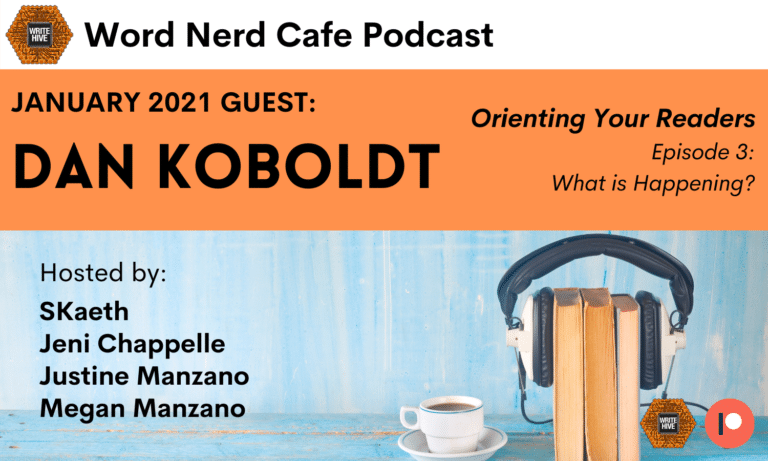Word Nerd Cafe: Jan 2021 Episode 3 with Dan Kobolt
WriteHive News
Greetings, Hivemind!
After a round of the team amusing themselves with “What even is happening?”, Word Nerd Cafe eased into Episode 3’s topic: What Is Happening?. What the team eventually gets around to talking about is making certain that the reader has a firm understanding of the story. Remember that the initial episodes of Word Nerd Cafe are about openings and beginnings of a novel. While we are busy in our own heads trying to establish the world, let’s make sure our readers can follow along. After all, if the tale is going to jump from place to place and you aren’t hand-holding the reader early on, not many people will stick around to find out will they?
—
Skeptic summoned the avatar of their editor Carly, now stuck in a circle decorated with ornate glyphs and runes. Clad in dark robes of crimson and black, the ink she uses to mark up eldritch manuscripts from the Authors With No Name, But Decent Footwear.
“Why have you summoned me?”
“I require help. I am not enough to handle the forces of boring prose, syntax and grammar.”
“You forgot the Oxford comma there.”
“How can you tell? We’re talking.”
—
Gentle Reader, if this scene had continued, we here at Write Hive imagine you would quickly have to backtrack and re-read a section in order to keep everything straight.
Justine makes the point that an opening chapter where the reader is in the character’s head isn’t an ideal situation. Referencing the first episode where we talked about having action happen, but also letting the reader into the main character’s head. This is the other side of the equation; it’s fine to be in the character’s head, but in the first five pages something needs to happen.
Further, “nothing” is a thing to avoid. It’s okay for a character to have introspection, or to be introspective during a scene. “Nothing” refers to “Jim wakes up. Jim uses the bathroom. Jim makes scrambled eggs for breakfast. Jim irons his shirt for work.” (Carly? Who is Jim? Do you know who Jim is? — Editor’s note: not in the least!) While this technically pushes the story forward, it’s not in a way a reader would want to care about.
he best opening scenes tell readers about the main character. Showing the reader what the character is doing, or more specifically why the character is acting in their specific way, will go a long way to tell the reader about their personality.
“Jim greeted the dawn with boundless enthusiasm. Another day to collect consumer debt, he cheered as he went downstairs and prepared his breakfast. I saw yesterday that there’s a disabled woman who can’t work who owes $17,000 on a car loan. I hope I land that one. I love making people squirm.”
Here we learn that Jim is an upbeat person with a sadistic side. That immediately makes the story (of Jim, anyway) far more interesting.
The Word Nerd Cafe team go into far more detail, so check out Episode 3 and find out the rest!

